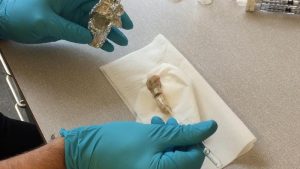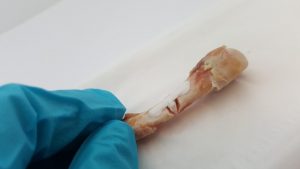According to the National Institute of Health (NIH), more than 53 million people in the United States have osteoporosis or are at risk of experiencing an osteoporosis-associated bone fracture. And, over six million fractures will occur in the U.S. every year.
And, if you have ever broken a bone, you know just how painful and inconvenient plates, screws and pins are! Not to mention slow to heal. Well, thanks to research scientists in Sweden, loose screws and annoying plates may soon become a thing of the past. Scientists from the KTH Royal Institute of Technology and the Karolinska Institute have stumbled upon a novel solution to treat fractures involving dental resin composites used for bonding broken teeth and filling cavities.
These savvy Swedes observed how well dental adhesives worked for teeth and considered something similar for bones. So what they developed was a biocompatible patch, which is designed to adhere to wet bone, isn’t toxic and therefore, can’t be rejected by the body. What’s more, the procedure to fix a fractured bone is so simple, it only takes five minutes.
A paper on the research was recently published in the journal Advanced Functional Materials. According to the study, the process works something like this: “First, a primer is applied directly to the bone, eating away its surface to expose its collagen fibers. Next, an adhesive resin is applied which contains tiny fibers of its own that become enmeshed with those of the exposed collagen. Finally, in a process referred to as thiol-Ene coupling, the resin is hardened by exposing it to LED light,” just the way dentists do when fixing damaged teeth.
When the patch was tested on rat bones, researchers found that it was so effective that it had 55 percent more bonding strength than commercially-available dental resin. They also found that the patch provided enough load-bearing strength to hold broken bones together. The results have been so significant that the technology is not only ready for clinical trials, but also is being commercially developed by startup Biomedical Bonding AB.
“We have finally managed to identify a surgically-realizable adhesive to fix bone fractures,” said lead scientist Michael Malkoch, a professor of fiber and polymer technology at the KTH Royal Institute and founder of Biomedical Bonding AB. “The chemistry, materials and methodology we used, result in extraordinary adhesion and fixation to the wet bone, which in most cases is incredibly difficult.”
Professor Malkoch and his colleagues believe this method leads to fewer costs for patients, allows for a shorter recovery, minimizes pain, and enables patients to start exercising within a few days after the procedure. It’s a paradigm shift in treating fractures that is long overdue and like Crazy Glue—I hope it sticks!


Strategic Communications Professional/Content Strategist/Marketing Communications Consultant





